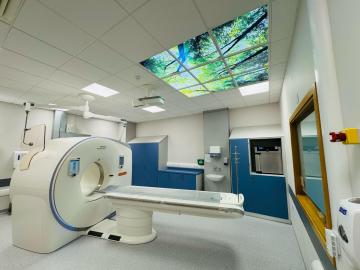Computed Tomography (CT) Radiofrequency Ablation (RFA) Scans
A computerised tomography (CT) scan is a medical test that uses X-rays and a computer to create detailed images of the structures inside the body, including the internal organs, blood vessels and bones.
A CT scan can be used to guide a Consultant Radiologist to carry out Radiofrequency Ablation of some cancers. A Radiofrequency Ablation is a minimally invasive procedure that uses electrical heat and energy to destroy cancer cells. The Consultant Radiologist uses CT imaging to guide a thin needle through the skin into the cancer tissue where they then turn on the electrical energy to destroy the cancerous cells. Common sites that can be ablated include tumours of the kidney or liver.
Images will be taken before, during and after Radiofrequency Ablation.
Radiofrequency Ablations are generally carried out under an inpatient admission and a general anaesthetic is usually required for these procedures.
- You will receive an appointment letter which will mention anything you need to do to prepare for your procedure. This letter will provide you with an admission date and time and expected length of stay.
- If you are on blood thinning medication, you may be asked to stop taking this medication for a certain number of days – this will be explained to you.
- You will need to fast from 12 midnight prior to the procedure.
- You will arrive at the Admissions Department on the day of admission and your information will be checked. The admissions team will inform you which ward to go to.
- In the ward you will be shown to your room where you will have pre-checks carried out by the nursing team.
- A small needle/cannula may be inserted into your arm. This can be used to administer any medication required e.g. anaesthetic, contrast agents, antibiotics.
- You may also have bloods taken.
- You may need to have a chest x-ray and an ECG as part of the pre-check for your procedure.
- You may meet with the Anaesthetist who will carry out a pre-operative assessment to ensure it is safe for you to have an anaesthetic.
- You will be called to the Radiology Department for your procedure. Here you will meet the Consultant Radiologist who will be performing the Radiofrequency Ablation. They will explain the procedure outlining the risks involved and ask you to sign a consent form. You can ask the Consultant Radiologist any questions you may have at this time.
- For the procedure you will be moved to the CT scan room. Here you will meet the team who will assist the Consultant Radiologist with the procedure (Anaesthetist, Nurses and Radiographers).
- During the procedure, you will lie on a table that can slide in or out of the CT scanner which is a donut/ring shaped machine. You will be connected up to an ECG monitor and a Blood Pressure monitor.
- At this point, the Anaesthetist will give you the anaesthetic medication and you will be asleep for the entire procedure.
- A grid will be placed over the area to be ablated and planning scans carried out. Once the planning scans are complete, the Consultant Radiologist reviews the images and pinpoints the location to be ablated. Ultrasound may also be used to locate the lesion. The Consultant Radiologist will mark this location with a skin marker on your skin.
- The skin will be cleaned using an antiseptic solution in the area that the ablation is to occur. The Consultant Radiologist will insert a needle into the area to be ablated and will use CT scanning numerous times ensure the needle is in the correct location. Once in the correct location, an ablation probe is inserted into the lesion and the electrical energy is switched on to ablate the cancerous tissue.
- Once the ablation is complete, a final set of scans are carried out to ensure the ablation has been fully successful. The needle is removed and a sterile dressing is applied to the area. You will be awoken from the anaesthetic.
- The procedure will take between 1 and 3 hours, depending on the location where the procedure needs to be carried out.
- Once the procedure is complete, the team will assist you off the table and onto your bed. You will be monitored for a time in the Radiology Recovery room before returning to the ward or day unit.
- You will be given instructions by the team as to what to expect after the procedure. Advice will be given regarding pain relief, possible complications, what to do in the case of complications, would care etc.
- The Consultant Radiologist will send the Radiology report to your referring doctor and advise as to any follow-up that may be required.
Consultant Radiologists
Consultants who perform this service
How to get in touch
Contact information
Radiofrequency Ablation (RFA) Contact
GP Referral information
Phone: (01) 263 8030
Email: Radiology@svph.ie
Healthlink e-referrals
Please ensure to include:
-
Patients Full Name
-
Patients Date of Birth
-
Patients Address
-
Specific CT scan required
-
Clinical Information/Reason for referral
-
GP Signature and MCN
-
Date of Referral
CT’s are available by appointment only






